Flags of Europe

This is a list of international, national and subnational flags used in Europe.
Supranational and international flags
| Flag | Date | Use | Description |
|---|---|---|---|
 | 1957/1958– | Flag of the Benelux | Combines features from the flags of the member countries: Belgium, the Netherlands and Luxembourg |
 | Unknown | Flag of the Central Commission for Navigation on the Rhine | Light blue flag with four dark blue stripes horizontally across the lower half of the flag covered by a yellow anchor. Top half has six yellow stars in a circle. |
 | 1990s– | Flag of the Central European Free Trade Agreement (CEFTA) | |
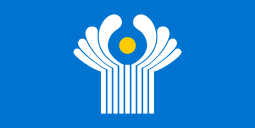 | 1991– | Flag of the Commonwealth of Independent States | The flag of the Commonwealth of Independent States is blue with the emblem of the organisation in the centre. |
 | 1955– | Flag of the Council of Europe | A circle of 12 upward-oriented 5-pointed golden stars centred on a blue field: represents the continent beyond the organisations as the Flag of Europe |
| 1986[1]– | Flag of the European Union[2] | ||
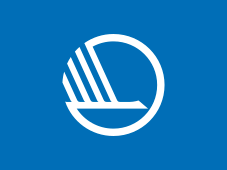 | 1984– | Flag of the Nordic Council | White stylised swan in a white circle upon a blue background. |
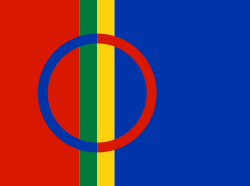 | 1986– | Flag of the Sami people |
Flags of European sovereign states
| Flag | Date | Use | Description |
|---|---|---|---|
 | 1912– | Flag of Albania | The flag of Albania, adopted in April 1912, is a red flag with a black two-headed eagle in the centre. It is derived from the seal of Gjergj Kastriot Skanderbeg, a 15th-century Albanian who led the revolt against the Ottoman Empire that resulted in brief independence for Albania from 1443 to 1478. |
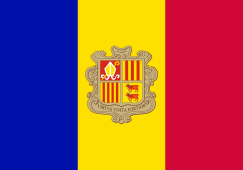 | 1866– | Flag of Andorra | The flag of Andorra, adopted in 1866, is a tricolour of blue, yellow, and red with the coat of arms of Andorra in the centre. It is based on the flags of France and Spain. The coat of arms of Andorra is based on the Catalan flag (4-red-coloured ribbons with yellow background). |
 | 1918–1920 1991– | Flag of Armenia[a] | After gaining independence, the First Republic of Armenia adopted the modern Armenian tricolor. The independent Armenian government selected the colours used during the last period of Rubenid Dynasty, red, blue and yellow. The Red emblematizes the Armenian Highland, the Armenian people's continued struggle for survival, maintenance of the Christian faith, Armenia's independence and freedom. The Blue emblematizes the will of the people of Armenia to live beneath peaceful skies. The Orange emblematizes the creative talent and hard-working nature of the people of Armenia. |
 | 1918 – 1938 1945 – | Flag of Austria | Originally adopted in 1918, was officially adopted (again) in 1945, after being banned during World War II.
Stripes of red and white have been a collective emblem of Austria for over 800 years, and their first usage on the flag occurred in 1191. According to long established legend, the red and white flag was designed to resemble the bloodstained white coat worn by the Duke of Austria during a fierce battle. |
 | 1918 – 1920 1991 – | Flag of Azerbaijan[a] | Originally adopted in 1918 as a flag of the Democratic Republic of Azerbaijan, was officially adopted again in 1991, after Azerbaijan gained its independence.
The flag of Azerbaijan is the national ensign of Azerbaijan. It consists of three equal horizontal bands colored blue, red, and green, with a white crescent and an eight-pointed star are centered in the red band. The blue band refers to Turkic heritage, the red is for progress and Europeanisation and the green refers to Islam. |
 | 1995– | Flag of Belarus | Belarus' flag was officially adopted on May 16, 1995. The dominant red and green were colours used on its flag when it was a republic of the former Soviet Union. The woven fabric ornament on the left uses traditional Belarusian red and white colours. |
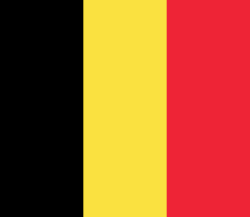 | 1831– | Flag of Belgium | The flag was officially adopted on January 23, 1831.
Black, gold and red are symbolic of the country's coat of arms. The three striped vertical layout was inspired by the French Tricolour. Black and gold were chosen, being the colours of the Duchy of Brabant where the Belgian Revolution started. Red was added as a symbol of the blood spilled during the uprising. |
 | 1998 – | Flag of Bosnia and Herzegovina | The flag of Bosnia and Herzegovina consists of a wide medium blue vertical band on the fly side with a yellow isosceles triangle abutting the band and the top of the flag. The remainder of the flag is medium blue with seven five-pointed white stars and two half stars top and bottom along the hypotenuse of the triangle. The three points of the triangle stand for the three nations of Bosnia: Bosniaks, Croats, and Serbs. It is said to represent the map of Bosnia. |
 | 1878 – 1946 1991 – | Flag of Bulgaria | The flag of Bulgaria was adopted in 1989 and consists of three horizontal bands of white, green and red. |
 | 1990 – | Flag of Croatia | The flag of Croatia, adopted in December 1990, consists of three equal horizontal stripes of red, white and blue, which has been the Croatian flag since 1848. In the middle is the Coat of arms of Croatia. |
 | 1960 – | Flag of Cyprus[b] | The flag was officially adopted on August 16, 1960.
The island is depicted in a copper shade representative of its name; the name Cyprus has roots in the Sumerian word for copper (zubar) from the large deposits of copper found on the island. The crossed green olive branches symbolise the hope for peace between the Turks and the Greeks. It was designed by İsmet Güney, a Turkish Cypriot painter. |
 | 1920 – 1939 1945 – | Flag of the Czech Republic | The first flag of Czechoslovakia was white over red, and those colours are the heraldic colours of Bohemia. The blue triangle was added to the flag in an effort to distinguish it from the flag of Poland, and blue is said to represent the State of Moravia. |
 | 1219 – | Flag of Denmark | It is the world's oldest state flag still in use. Legend has it that it appeared as a sign from heaven to King Valdemar II in 1219.
Known as the Dannebrog ("Danish Cloth"), this blood-red flag with an off-centred white cross (a "Scandinavian Cross") became a model for other regional flags. |
 | 1918 – 1940 1990 – | Flag of Estonia | It was officially re-adopted on May 8, 1990.
Blue represents loyalty, and the country's beautiful blue skies, seas and lakes; black is symbolic of past oppression and the fertile soil; and white represents virtue, winter snows, and Estonia's long struggle for freedom and independence. |
 | 1918 – | Flag of Finland | It was officially adopted on May 29, 1918.
The off-centred blue cross is based on the Scandinavian Cross, widely used on Scandinavian national flags. The blue colour is symbolic of blue skies, and the thousands of lakes in Finland. The white represents the winter snows. |
 | 1794 – 1814 1830 – | Flag of France | It was officially adopted on February 15, 1794.
The tricolore consists of three vertical bands of equal width, displaying the country's national colours: blue, white, and red. The blue band is positioned nearest the flag-staff, the white in the middle, and the red on the outside. Red, white and blue have come to represent liberty, equality and fraternity—the ideals of the French Revolution. Blue and red are also the time-honoured colours of Paris, while white is the colour of the Royal House of Bourbon. |
 | 2004 – | Flag of Georgia[a] | This recently adopted flag is a simple white rectangle, with a central red cross connecting all four sides of the flag; in each of the four corners is a small red cross. The flag is based on a historic five-cross design that dates back to the 14th century. |
 | 1919 – 1933 1949 – | Flag of Germany | It was officially re-adopted on May 23, 1949 and subsequently used by West Germany while the country was divided into East and West before reunification in 1990.
The tricolour flag was designed in 1832, and the black, red, and gold colours were taken from the uniforms of German soldiers during the Napoleonic Wars (Out of the blackness (black) of servitude through bloody (red) battles to the golden (gold) light of freedom.[3]) or taken from the coat of arms of Holy Roman Empire. |
 | 1978 – (Civil flag since 1822) | Flag of Greece | The current flag of Greece was adopted as a civil flag and ensign in 1822, and as the national flag in 1978.
It features a white cross and a combination of nine, five blue and four white, horizontal stripes. The shade of blue has varied over the years, and darker blue (shown) is now commonly used. The alternating white and blue stripes are said to represent the nine syllables of the phrase "Eleftheria i thanatos" ("Freedom or Death"), a popular motto during the War of Independence. During the Kingdom of Greece, a crown was added in the centre of the cross. Greece's national flag between 1822 and 1970 featured a simple white cross on a blue background. It is not known why this version was adopted, and not a blue cross on a white background as was popular in the War of Independence. During the dictatorship, a navy blue version of the current flag with proportions of 7:12 was used. |
 | 1957 – | Flag of Hungary | The flag of Hungary was officially adopted in 1848.
The tricolour design is modelled after that of the flag of France. The colors are derived from the historical Hungarian coat of arms. Red is said to symbolise strength, white faithfulness, and green hope. |
 | 1915 – | Flag of Iceland | The flag of Iceland was adopted in June 1915 to represent Iceland. In June 1944 it was instated as the flag of the independent republic of Iceland. Like other Scandinavian flags, it is based on the Scandinavian Cross. It is a reverse colour image of the Flag of Norway. The blue represents the sea, the white represents the snow and glaciers and the red symbolises volcanic lava. |
 | 1922 – | Flag of Ireland | Although dating from the 19th century, the tricolour flag of Ireland was not popularised until its use by rebels during the 1916 Easter Rising. It was officially adopted by the revolutionary First Dáil (assembly) of the Irish Republic on January 21, 1919 and used thereafter by the Irish Free State. The current 1937 Constitution of Ireland defines it as the national flag.
Modeled after the French tricolour, the colours of the Irish tricolour symbolises two communities. Green represents the Roman Catholic nationalist tradition. Orange represents the Protestant unionist community. White symbolises peace between both. |
 | 1948 – | Flag of Italy | Derived from an original design by Napoleon, it consists of three vertical bands of equal width, displaying the national colours of Italy: green, white, and red. Green stands for hope, white for loyalty and red represent the blood spread to unify the country. |
 | 1992 – | Flag of Kazakhstan[d] | |
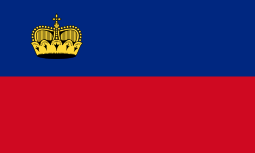 | 1937 – | Flag of Liechtenstein | The flag of Liechtenstein consists of two horizontal bands of blue and red with a gold crown in the canton. |
 | 1918 – 1940 1990 – | Flag of Latvia | The flag of Latvia was officially re-adopted on February 27, 1990.
The design is adopted from a 13th-century chronicle where "red divided by white" is said to be a Latvian flag. To differ from Austrian flag, the proportion 2:1:2 and "Latvian red" color has been adopted. |
 | 1918 – 1940 1989 – | Flag of Lithuania | The flag of Lithuania was officially re-adopted on March 20, 1989, before Lithuania gained independence from the Soviet Union in 1990.
Yellow is symbolic of the country's wheat fields, green symbolic of the forests, and red symbolises patriotism. Collectively the colours represent hope for the future, freedom from oppression, and the courage of the Lithuanian people. |
 | 1845 – | Flag of Luxembourg | The flag of Luxembourg was officially adopted in 1972, although used since 1848 following Luxembourg's independence from the Netherlands in the late 19th century.
The flag uses a combination of red, white, and blue that date to the 13th century, and the Grand Duke's coat of arms. |
 | 1995 – | Flag of Macedonia | The flag of the Republic of Macedonia depicts a rising yellow sun with eight rays extending to the edges of the red field. It represents "the new sun of liberty", evoked in the Macedonian national anthem Denes nad Makedonija (Today Over Macedonia). |
 | 1964 – | Flag of Malta | The flag of Malta was officially adopted on September 21, 1964.
The flag uses the traditional red and white colours which pre-date those of the Knights of Malta and which Government emulate the arms of the former Universitas of Mdina. The George Cross (upper left), outlined in red, was added to the flag in the 1940s, as King George VI of the United Kingdom presented it to islanders for outstanding gallantry during World War II. |
 | 1990 – | Flag of Moldova | Moldova's flag was officially adopted on May 12, 1990. Once part of Romania, Moldova's flag reflects that association, as the two countries use almost identical shades of red, yellow and blue in their national flags. The centred Moldova shield's main feature is a golden eagle holding an Orthodox Christian Cross in its beak. The olive branch is said to symbolise peace. |
 | 1881 – | Flag of Monaco | The flag of Monaco has two horizontal bands of red and white—these have been the heraldic colours of the House of Grimaldi since at least 1339. |
 | 2004 – | Flag of Montenegro | The flag of Montenegro, adopted in July 2004, is a red banner bearing the coat of arms adopted in 1993. The coat of arms derives from those of King Nikola. |
 | 1937 – | Flag of the Netherlands | The flag of the Netherlands was officially adopted on February 19, 1937.
At one time this tricolour flag was orange, white, and blue, as those were the livery colours of William of Orange, a Dutch prince. In the 17th century, red replaced the orange as a flag colour, because the orange dye used on the flag was unstable, and turned red after exposure to the sun. It is the oldest tricolour flag still in national use[4] and has influenced both the French[5] (1794) and Russian flag[6] (1693), both of these flags have in turn influenced many other European and African flags. |
 | 1821 – 1844 1898 – | Flag of Norway | The flag of Norway is red with a blue Scandinavian cross outlined in white; the vertical part of the cross is shifted to the hoist side in the style of the Dannebrog, the flag of Denmark. It was adopted in 1821, but a union mark was added in the canton from 1844 to 1898. |
 | 1919 – | Flag of Poland | The flag of Poland was officially adopted on August 1, 1919.
The colours red and white have long been associated with Poland and its coat of arms,[7] at least since 3 May 1791. |
 | 1911 – | Flag of Portugal | The flag of Portugal was officially adopted on June 30, 1911.
The design is that of a rectangular bi-colour (2:3 ratio) with a field vertically divided into two stripes of different width—a green stripe on the hoist, and a larger red stripe on the fly. The minor version of the national coat of arms (armillary sphere and Portuguese shield) is entered over the boundary between the colours at equal distance from the upper and lower edges. The field colours, especially the green, originally represented a radical republican-inspired change that broke the bond with the former religious monarchical flag. In the ensuing decades, these colours were popularly propagandised as representing the hope of the nation (green) and the blood (red) of those who died defending it, as a means to endow them with a more patriotic and dignified, therefore less political, sentiment. |
 | 1848, 1867 – 1948 1989 – | Flag of Romania | The flag of Romania was officially re-adopted in 1989. The first red-yellow-blue flag dates from 1834 but the colours themselves are thought to have had special significance from earlier times. The current layout dates since 1848.
A vertical tricolour of bands of blue, yellow, and red of equal width and overall proportions of 2:3 (height-width). It could be inspired by the French flag. |
 | 1883 – 1918 1993 – | Flag of Russia | The Russian Federation flag was officially adopted on August 22, 1991. The flag was hoisted shortly after the former Soviet Union collapsed. The white, red and blue are Pan-Slavic colours. |
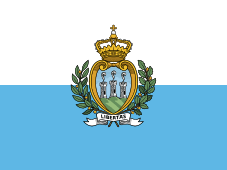 | 1862 – | Flag of San Marino | The flag of San Marino comprises equal horizontal bands of white and light blue with the national coat of arms superimposed in the centre. |
 | 2004 – | Flag of Serbia | The flag of Serbia consists of three horizontal bands of red, blue and white, with the coat-of-arms located left of centre. By accident or design the colours are that of the Russian flag reversed. Flag with three horizontal bands of red, blue and white has been used as the national flag of Serbia and Serbs since 1835. Red, blue, and white are considered Pan-Slavic colours, but red and blue also occur on flags attributed to a 13th-century king of Serbia. The entered coat of arms of Serbia is double-headed white eagle and a red shield with a white cross surrounded by 4 firesteels ("ocila"), a symbol that draws roots from Byzantine coat of arms (where cross is surrounded by four Greek letters Beta) and from much deeper past of the Balkan peninsula, as it can be seen on 7000 years old Vinca culture[8] pottery and many other later traditional Balkan cultural remains.[9] |
 | 1992 – | Flag of Slovakia | The flag of Slovakia was officially adopted on September 1, 1992.
Red, white, and blue are traditional Pan-Slavic colours. The entered Slovakian arms features a dominant white cross atop a blue symbolic reference to the European country's mountains. |
 | 1991 – | Flag of Slovenia | The flag of Slovenia was officially adopted on June 24, 1991.
Red, white, and blue are taken from the Carniolan coat of arms. The flag without the coat of arms was in use from 1848 to 1945. The Slovenian coat of arms features three gold stars, symbolizing the Counts of Celje. The mountains shown in white are representative of the Alps, and Mount Triglav, Slovenia's national symbol, in particular; the wavy blue lines across the bottom indicate Slovenia's access to the sea. |
 | (1785 original design)
1981 – |
Flag of Spain | The flag of Spain was officially adopted on 19th July 1927, as merchant naval flag and on 29th December 1978 as the national flag on the current Spanish Constitution. Nevertheless, the first original reference dates back to 15th May 1785 when Charles III of Spain adopted one of the designs proposed by Antonio Valdés y Bazán, commissioned by the king himself, in order to easily differentiate his ships from those of other European nations given the fact that many used the royal coat of arms over a white background, i.e. the French Bourbon royal flag.
The red and golden-yellow colours were used after that day with mere changes on the coat of arms (with the exception of the Spanish Second Republic) and are the original colours found within the coat of arms of the medieval kingdoms of Castile, Aragon and Navarre, first united by King Ferdinand II of Aragon and Queen Isabella I of Castile. |
 | 1569 – | Flag of Sweden | The flag of Sweden was officially adopted on June 22, 1906.
The off-centred yellow cross (The Scandinavian Cross) is taken from the Danish flag. The yellow and blue colours are taken from the national coat of arms. |
 | 1889 – | Flag of Switzerland | The flag of Switzerland consists of a red square with a bold, equilateral white Greek cross in the centre. It is one of only two square flags, the other being that of the Vatican City. It is based on the flag of the Canton of Schwyz, which dates back to 1474 at least. |
 | 1844 – | Flag of Turkey[c] | The flag of Turkey is a red flag with a white crescent moon and a star in its centre. The flag is called Ay Yıldız (literally, moon star.) or Albayrak (Red flag) which were adopted in 1844 with the Tanzimat reforms; though the shape, placement and shade of the colour vary. The geometric proportions of the flag were legally standardised with the Turkish Flag Law in 1936. |
 | 1918 – 1920 1992 – | Flag of Ukraine | Ukraine's flag was adopted on September 4, 1991, shortly after the collapse of the former Soviet Union. This is the country's original flag used by the short-lived Ukrainian People's Republic, but it was banned for many decades under Soviet regime. The shade of blue is said to be symbolic of the sky, while the yellow represents Ukraine's golden wheat fields. |
 | 1801 – | Flag of the United Kingdom | The current flag of the United Kingdom dates from the Act of Union 1800, which merged the Kingdom of Great Britain and the Kingdom of Ireland to form the United Kingdom of Great Britain and Ireland.
The 'Union Jack' merges the red cross of Saint George (patron saint of England), edged in white, superimposed on the diagonal red cross of Saint Patrick (patron saint of Ireland), which are superimposed on the saltire of Saint Andrew (patron saint of Scotland). The flag of Wales, the other country of the United Kingdom, is not graphically represented. |
 | 1929 – | Flag of the Vatican City | The flag of Vatican City, adopted in June 1929, consists of two vertical bands of yellow and white with the crossed keys of Saint Peter and the Papal Tiara centred in the white band. It is one of only two square country flags in the world, the other being that of Switzerland. |
Flags of other European sovereign entities
| Flag | Date | Use | Description |
|---|---|---|---|
.svg.png) | 1130 – | Sovereign Military Order of Malta | The flag of the Sovereign Military Order of Malta is a red rectangular flag quartered by a white cross. |
Disputed or partially recognised states
| Flag | Date | Use | Claimed by | Description |
|---|---|---|---|---|
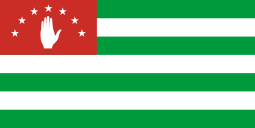 | 1992 – | Flag of Abkhazia[a] | Georgia | The flag of Abkhazia consists of seven green and white stripes with a red upper left canton bearing a white open right hand and seven white stars. |
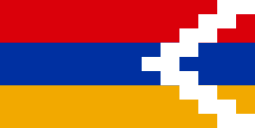 | 1992 – | Flag of Artsakh[a] | Armenia | The flag of Artsakh is based on the Flag of Armenia, and has a white pattern added. |
 | 2008 – | Flag of Kosovo | Serbia | Adopted by Kosovo on 17 February 2008 as it unilaterally proclaimed independence from Serbia. |
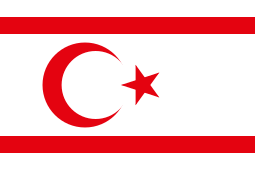 | 1984 – | Flag of Northern Cyprus[b] | Cyprus | Adopted by the Turkish Republic of Northern Cyprus (recognized only by Turkey and the Autonomous Republic of Nakhichevan) on 7 March 1984 following the Turkish invasion and the occupation of the northern part of the island in 1974. |
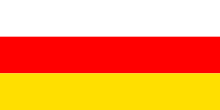 | 1990 – | Flag of South Ossetia[a] | Georgia | The flag of the South Ossetia is a tricolour, the top stripe white, the middle stripe red and the bottom stripe yellow. |
.svg.png) | 2000 – | Flag of Transnistria | Moldova | The flag of Transnistria consists of three stripes (red-green-red) and the Soviet hammer and sickle; it is based on the flag of the Moldavian SSR. |
Flags of European dependencies
| Flag | Date | Use | State (status) | Description |
|---|---|---|---|---|
 | 1960 – | Flag of Akrotiri and Dhekelia | UK (overseas territory) | Same as the United Kingdom. |
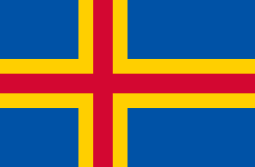 | 1954 – | Flag of Åland | Finland (autonomous region) | The flag was officially adopted 3 April 1954. As of 1992, it serves as the civil and state flag and ensign. This traditional Scandinavian Cross flag features blue, yellow, and red, all said to be borrowed from the national colours of Sweden and Finland. |
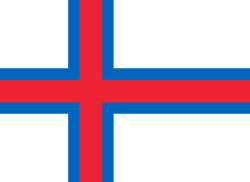 | 1940 – | Flag of Faroe Islands | Denmark (autonomous country) | The flag of the Faroe Islands, called Merkið, was first used in 1919, was mandated by the British as the civil and state ensign in 1940, and became the official civil and state flag and ensign on 23 March 1948. The flag uses Norwegian colours, commemorating the Faroes once being part of Norway. |
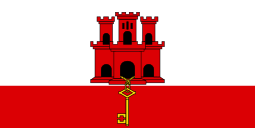 | 1502 – | Flag of Gibraltar | UK (overseas territory) | The Gibraltar flag dates from 1502, as it is based on the original arms granted it by Spain. The red and white field is taken from the arms, and it is dominated by a red three-towered fortress, complete with a gold key. |
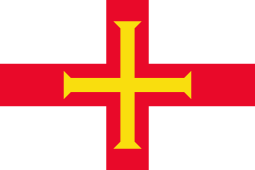 | 1985 – | Flag of Guernsey | UK (crown dependency) | The flag of Guernsey, adopted in 1985, consists of the red cross of St. George with an additional gold cross within it. The change was prompted by confusion over Guernsey and England using the same flag. The gold cross represents Duke William of Normandy, who had such a cross on his flag in the Battle of Hastings, given to him by Pope Alexander II. |
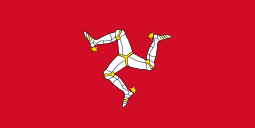 | c13 – | Flag of the Isle of Man | UK (crown dependency) | The flag of the Isle of Man features a red field with a centred triskelion of three bent legs joined at a central point. |
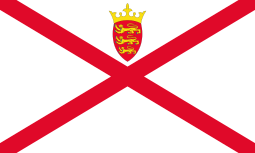 | 1980 – | Flag of Jersey | UK (crown dependency) | The flag of Jersey, adopted in June 1979, is white with a diagonal red cross, surmounted by a yellow Plantagenet crown, the badge of Jersey (a red shield holding the three leopards of Normandy in yellow). Prior to this, the flag was a plain red saltire on a white field. |
Flags of European sub-divisions
Austria
| Flag | Date | Use | Description |
|---|---|---|---|
 | 1921 – | Flag of Burgenland | A horizontal biicolor of yellow and red. |
 | 1946 – | Flag of Carinthia | A horizontal tricolor of yellow, red and white. |
 | 1954 – | Flag of Lower Austria | A horizontal bicolor of blue and yellow. |
 | 1921 – | Flag of Salzburg | A bicolor of white over green. |
 | 1960 – | Flag of Styria | A bicolor of red over white. |
 | 1945 – | Flag of Tyrol | The flag of Tyrol is a white over red bicolor. |
 | 1949 – | Flag of Upper Austria | The flag of Upper Austria is a white over red bicolor. |
 | 1938 – | Flag of Vorarlberg | A bicolor of red over white. |
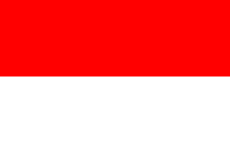 | 1844 – | Flag of Vienna | A bicolor of red over white. |
Belgium
| Flag | Date | Use | Description |
|---|---|---|---|
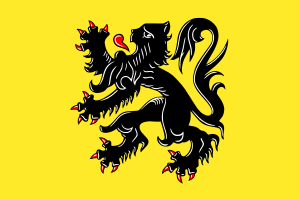 | 1973 – | Flag of Flanders | Flanders is a Dutch-speaking ethnic region in the northern half of Belgium. |
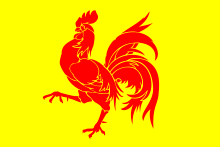 | 1991 – | Flag of Wallonia | Wallonia is a mostly French-speaking ethnic region comprising the southern half of Belgium. |
Bosnia and Herzegovina
| Flag | Date | Use | Description |
|---|---|---|---|
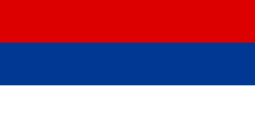 | 1995– | Flag of Republika Srpska | A horizontal tricolour of red, blue and white, very similar to the flag of Serbia without the Coat of Arms (with slightly differently coloured shades). |
France
| Flag | Date | Use | Description |
|---|---|---|---|
 | 1923 – | Flag of Brittany | The flag, called Gwen ha du (White and black) was created in 1923 by Morvan Marchal (1900–1963, a member of various political and cultural organizations). He used as his inspiration the old Breton flag (a centred black cross on a white background), called Kroaz Du (Black cross), and the flags of the United States and Greece as these two countries were seen at that time as the respective symbols of liberty and democracy. The nine horizontal stripes represent the traditional dioceses of Brittany into which the duchy was divided historically. The five black stripes represent the French or Gallo speaking dioceses of Dol, Nantes, Rennes, Saint-Malo and Saint-Brieuc—while the four white stripes represent the Breton speaking dioceses of Trégor, Léon, Cornouaille and Vannes. The ermine canton recalls the ducal arms of Brittany. |
 | Flag of Bourgogne-Franche-Comté | ||
 | Flag of Centre-Val de Loire | ||
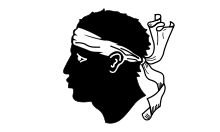 | 1755 – | Flag of Corsica | The Flag of Corsica was adopted by General of the Nation Pasquale di Paoli in 1755 and was based on a traditional flag used previously. It portrays a Moor's Head in black wearing a white bandana above his eyes on a white background. Previously, the bandana covered his eyes. |
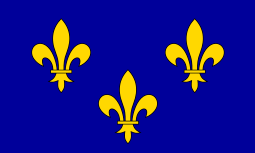 | Flag of Île-de-France | ||
 | Flag of Normandy | ||
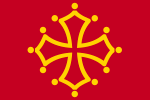 | 12th century – | Flag of Occitanie | |
 | Flag of Pays-de-la-Loire | ||
 | 12th century – | Flag of Provence-Alpes-Côte d'Azur | |
Georgia
| Flag | Date | Use | Description |
|---|---|---|---|
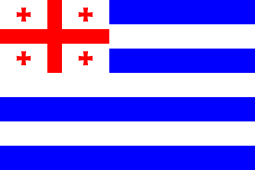 | 2004 – | Flag of Adjara | |
Germany
Many states have separate civil and state versions of their flags; the state flags (listed) include the state arms, while the civil versions don't. See Flags of German states.
| Flag | Date | Use | Description |
|---|---|---|---|
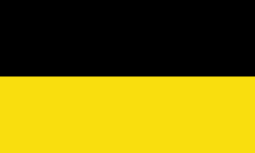 | 1954 – | Flag of Baden-Württemberg | A black over gold bi-color. |
.svg.png) .svg.png) | 1953 – | Flag of Bavaria | There are two official flags of Bavaria. One is an array of 21 or more lozenges of blue and white, the other is a white over blue bicolor. |
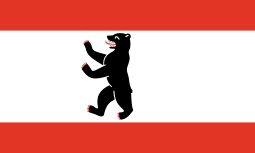 | 1954 –1990 (West Berlin) 1990 – | Flag of Berlin | White with red bars at the top and bottom, with a bear off-centre towards the hoist. |
 | 1991 – | Flag of Brandenburg | A horizontal bi-color of red over white, with the arms of the state (land), in the center. |
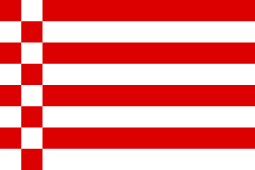 | 1952 – | Flag of Bremen | Eight or more alternating red and white stripes, checked at the hoist. |
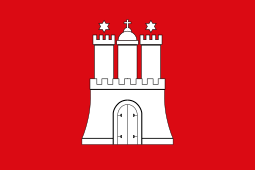 | 1751 – | Flag of Hamburg | A white castle with three towers and a closed gate. |
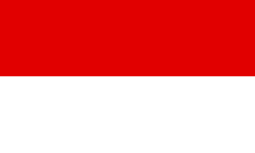 | 1948 – | Flag of Hesse | The state flag of Hesse consists of a bicolor of a red top and a bottom white stripe. |
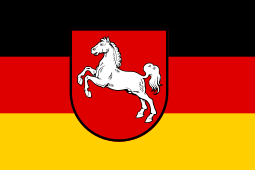 | 1951 – | Flag of Lower Saxony | The flag of Lower Saxony consists of the flag of the Federal Republic of Germany in Schwarz-Rot-Gold, with the coat of arms of Lower Saxony, shifted slightly toward the hoist. |
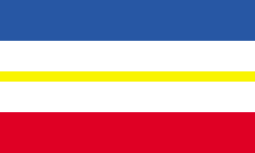 | 1990 – | Flag of Mecklenburg-Western Pomerania | |
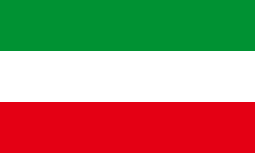 | 1953 – | Flag of North Rhine-Westphalia | A horizontal tricolour of green, white, and red. |
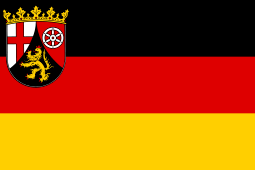 | 1945 – | Flag of Rhineland-Palatinate | The flag of Rhineland-Palatinate is a tricolor of three horizontal bands of black, red and gold. These colors are Germany's national colors and are sometimes referred to as schwarz-rot-gold. In the canton, or the upper left corner, are the arms of the state of Rhineland-Palatinate. |
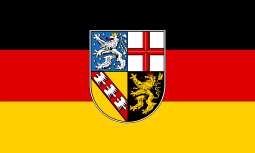 | 1957 – | Flag of Saarland | The flag of Saarland is based on the flag of Germany and is a black, red, and gold (yellow) horizontal tricolor. In the center of the flag is the coat of arms of Saarland. |
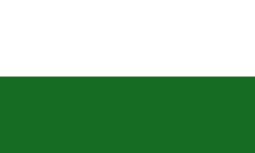 | 1991 – | Flag of Saxony | A bicolour of white over green. |
 | 1991 – | Flag of Saxony-Anhalt | The state flag of Saxony-Anhalt is a yellow and black bi-color. |
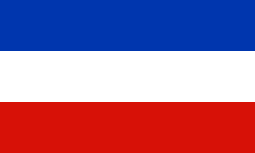 | 1948 – | Flag of Schleswig-Holstein | The state flag of Schleswig-Holstein is a horizontal tricolour of blue, white, and red. |
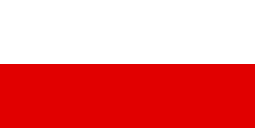 | 1991 – | Flag of Thuringia | The state flag of Thuringia consists of a bicolor of a white top and a bottom red stripecentre. |
Greece
| Flag | Date | Use | Description |
|---|---|---|---|
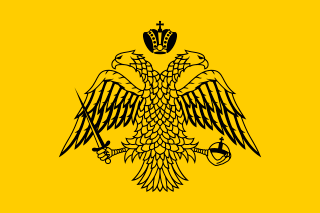 | 1900s – | Flag of Mount Athos | The flag of Mount Athos, adopted in 1900s, is a yellow banner bearing the double-headed eagle of the Byzantine Empire. |
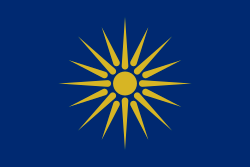 | 1980s – | Flag of Macedonia (Greece) | The flag of Macedonia (Greece), adopted in 1980s, is a blue banner featuring the Vergina Sun, the emblem of the Ancient Greek Kingdom of Macedon. |
 | 2000s – | Flag of Epirus | The flag of Epirus, adopted in the early 2000s, is a white field featuring various symbols from different periods of Epirus' history and the Greek words «ΠΕΡΙΦΕΡΕΙΑ ΗΠΕΙΡΟΥ», meaning "PREFECTURE OF EPIRUS". The symbols include an Ancient Greek Column of the Doric Order symbolizing the region's Ancient Greek heritage, a Roman road symbolizing its Ancient Roman period, the Castle of Ioannina symbolizing the Byzantine Empire's rule of Epirus as well as the Medieval period in general, the Bridge of Arta symbolizing the Ottoman Empire's rule over the region, Stars in a semi-circle symbolizing modern Epirus and the European Union of which Greece is a member state and a river and a hill symbolizing the landscape of Epirus. |
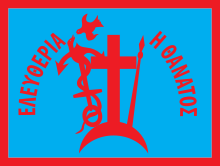 | 1821 – | Flag of Spetses | The flag of Spetses, adopted in early 1821 during the Greek Revolution, features an azure field surrounded by a thick red border, defaced with a Cross on an overturned Crescent (symbolizing the Christian Greek victory over the Muslim Ottoman Empire), a spear (symbolizing the armed struggle for freedom), an anchor (symbolizing the maritime tradition and merchant wealth of the island as well as most of Greece), a snake around the anchor (symbolizing the Goddess Athena, wisdom and the island's ancient Greek heritage), a dove (symbolizing peace, justice and prosperity) and the words «ΕΛΕΥΘΕΡΙΑ Ή ΘΑΝΑΤΟΣ», meaning "FREEDOM OR DEATH", Greece's National Motto. |
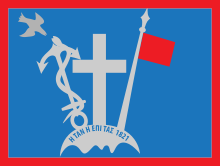 | 1821 – | Flag of Hydra | The flag of Hydra, adopted in early 1821 during the Greek Revolution, its design and symbolism are almost identical to those of the Flag of Spetses (see above), though the colours are slightly different. The Symbols are also almost identical, though instead of a spear there is a flagpole with a flag and some of the symbols are grey instead of red. |
 | 1828 – | Flag of Kastellorizo | The flag of Kastellorizo, adopted in early 1828 during the Greek Revolution, it features a white field surrounded by a blue border. It is defaced with a Cross, an Anchor and a Heart. On the left and right of these symbols are the words «ΜΕΓΙΣΤΗ» and «ΚΑΣΤΕΛΛΟΡΙΖΟ» ("MEGISTE" & "KASTELLORIZO"), the two names of the island. |
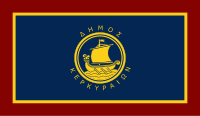 | 1864 – | Flag of Corfu | The flag of the island of Corfu, adopted in 1864 after the annexation of the United States of the Ionian Islands by the Kingdom of Greece as a gift to the George I of Greece by the United Kingdom, features a blue field surrounded by a golden border and a thicker dark red one. It is defaced with an Ancient Greek Galley which is surrounded by a circle and the words «ΔΗΜΟΣ ΚΕΡΚΥΡΑΙΩΝ» meaning "MUNICIPALITY/PEOPLE OF THE CORFIOTS". |
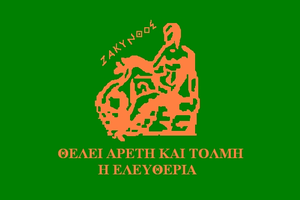 | 1864 – | Flag of Zakynthos | The flag of the island of Zakynthos, adopted in 1864 after the annexation of the United States of the Ionian Islands by the Kingdom of Greece as a gift to the George I of Greece by the United Kingdom, features a Green field with a golden depiction of Zakynthos (person), the figure from Ancient Greek Mythology after whom the island was named. Near the top left side of Zakynthos the name of the island in Greek («ΖΑΚΥΝΘΟΣ») is written while under the depiction is the island's motto, «ΘΕΛΕΙ ΑΡΕΤΗ ΚΑΙ ΤΟΛΜΗ Η ΕΛΕΥΘΕΡΙΑ» ("FREEDOM DEMANDS VALOUR AND BRAVERY") by the Zakynthian poet Andreas Kalvos. |
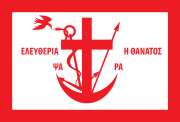 | 1821 – | Flag of Psara | The flag of the island of Psara, adopted in 1821 during the Greek Revolution, is almost identical in style and design to the flags of Hydra, Spetses and other islands (see above) with some differences. The field is white and the surrounding border is red while all the symbols it is defaced with are all red. The symbols are also almost identical though instead of a dove there is an eagle, probably a reference to the Eagle of Zeus, a symbol of power and authority. The flag features the words «ΕΛΕΥΘΕΡΙΑ Ή ΘΑΝΑΤΟΣ» ("FREEDOM OR DEATH", Greece's National Motto) and «ΨΑΡΑ» ("PSARA", the island's name in the Greek language). |
.svg.png) | 1821 – | Flag of Mani Peninsula | The flag of the island of the Mani Peninsula, adopted in 1821 during the Greek Revolution, features a white field with a blue Greek cross and the phrases «ΝΙΚΗ Ή ΘΑΝΑΤΟΣ» ("VICTORY OR DEATH", a traditional Greek battle cry) and «ΤΑΝ Ή ΕΠΙ ΤΑΣ» (a Laconic phrase said by Spartan mothers to their sons when they left for war; lit. "IT OR ON IT" meaning that if the Spartan is to return alive he should return with his shield [so as to have not dropped it and fled the battle] or be returned on it by his comrades, dead). |
Ireland
| Flag | Date | Use | Description |
|---|---|---|---|
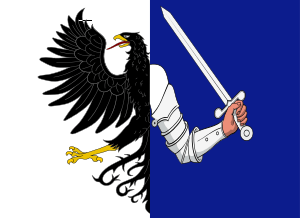 | Flag of Connacht | The flag of Connacht is a heraldic banner of the arms of Connacht, a dimidiated (divided in half from top to bottom) eagle and armed hand. | |
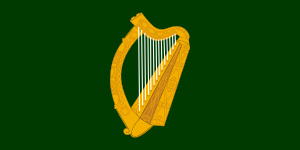 | Flag of Leinster | The flag of the Irish province of Leinster is a banner with the provincial coat of arms: a gold Irish harp with silver strings on a green field (blazon: vert a harp or stringed argent). These arms are similar to the arms of Ireland, which have the same device on a field of blue rather than green | |
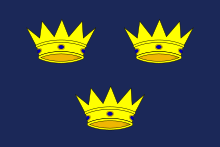 | Flag of Munster | The flag of Munster consists of three gold crowns on a blue field. The crowns were the arms of Ireland before being superseded by the golden harp in the 16th century. The meaning of the crowns on the flag is not certain, but one possibility is that they may represent three of the medieval Hiberno-Norman lordships in Munster; the O’Briens (Thomond), the Butlers (Ormond) and the Fitzgeralds (Desmond). | |
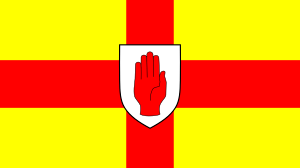 | Flag of Ulster | Ulster is one of the four traditional provinces of Ireland. Only three of the nine counties of Ulster are part of the Republic of Ireland, the other six making up Northern Ireland, part of the United Kingdom. However, the flag is still used to represent Ulster as a whole. The Red Hand of Ulster is a symbol that is either derived from the O'Neill dynasty, then the most prominent Irish clan in Ulster, or the Dextra Dei of early Christian iconography. The gold background featuring a red cross comes from the coat of arms of the Burkes, a Hiberno-Norman noble family. | |
Italy
| Flag | Date | Use | Description |
|---|---|---|---|
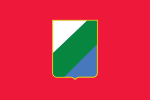 | 1999 – | Flag of Abruzzo | |
 | 1947 – | Flag of the Aosta Valley | The flag of the Aosta Valley consists of two vertical stripes (the left black the right red), sometimes with the arms of the Aosta Valley in the centre. |
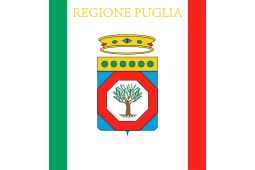 | 2001 – | Flag of Apulia | |
 | 1973 – | Flag of Basilicata | |
 | 1992 – | Flag of Calabria | |
 | 1971 – | Flag of Campania | The Campania Region has taken as its emblem the one given the Maritime Republic of Amalfi in its infancy. Said emblem consists of a red stripe on a white field
Regional Law n. 1 of July 21, 1971 |
 | 1992 – | Flag of Emilia Romagna | |
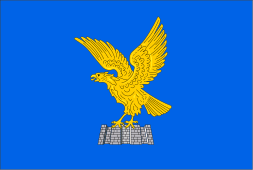 | 2001 – | Flag of Friuli-Venezia Giulia | |
 | 1992 – | Flag of Lazio | |
 | 1992 – | Flag of Lombardy | |
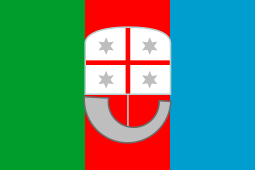 | 1997 – | Flag of Liguria | |
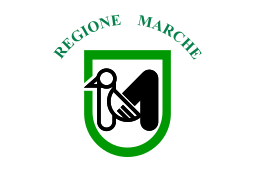 | 1995 – | Flag of Marche | |
 | 1995 – | Flag of Molise | |
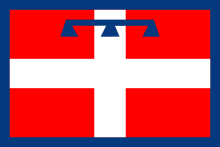 | 1995 – | Flag of Piedmont | |
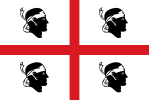 | 1999 – | Flag of Sardinia | |
.svg.png) | 1990 – | Flag of Sicily | The current flag was adopted July 28, 1990 under regional law N. 2, Art. 12. The law was later updated in 1998. It was not until January 1, 2000, under regional law N. 1, that the flag was adopted as the official symbol of Sicily, including legislation mandating public display of the flag at all Sicilian public buildings. The flag, officially used by the ancient Kingdom of Sicily, has existed in various forms since 1282.
The flag is rectangular in form and is characterised by the presence of the Trinacria (triskelion) in the centre. It features a softened image of the winged-head of Medusa and three ears of wheat (replacing snakeheads) representing the island's fertility. The three bent legs represent the island's three capes or points, while in mythology it is said to represent good luck and prosperity. The background of the flag is divided by a diagonal from left to right, and is coloured gold (lower left) and red-orange (upper right). The colours represent the cities of Palermo and Corleone, respectively, the first two to found a confederation against the Angevin rule. |
 | 1983 – | Flag of Trentino-Alto Adige/Südtirol | |
 | 1995 – | Flag of Tuscany | |
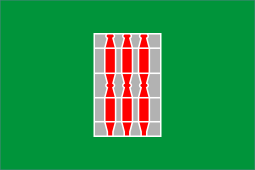 | 2003 – | Flag of Umbria | |
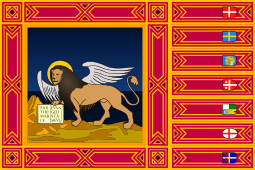 | 1999 – | Flag of Veneto | |
Malta
| Flag | Date | Use | Description |
|---|---|---|---|
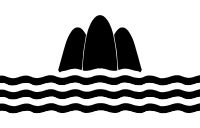 | 1964 – | Flag of Gozo | Symbolises the islands nickname 'The Island of the Three Hills', and also the fact that it is surrounded by sea. |
Netherlands
| Flag | Date | Use | Description |
|---|---|---|---|
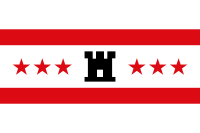 | 1947 – | Flag of Drenthe | |
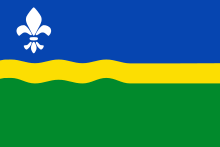 | 1986 – | Flag of Flevoland | The flag of Flevoland recalls how the new province was reclaimed from the IJsselmeer. The central yellow stripe, wavy then straight, symbolises the transformation of the sea into land. Its colour symbolises rapeseed, planted to stabilise the land. The blue represents water, the green the land.
The white fleur-de-lys (lily) is a pun. It commemorates Cornelis Lely, designer of the original polders, essential to the province. |
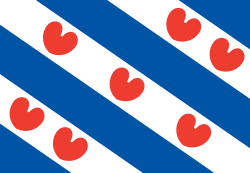 | 1897 – | Flag of Friesland | The flag of Friesland consists of four blue and three white diagonal stripes; in the white stripes are a total of seven red pompeblêden, leaves of yellow water-lily. |
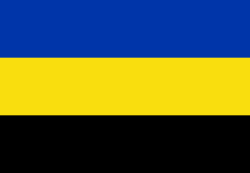 | Flag of Gelderland | ||
 | Flag of Groningen | ||
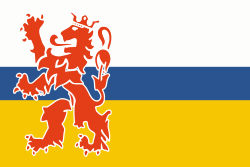 | Flag of Limburg | ||
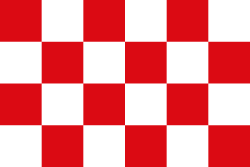 | 1959 – | Flag of North Brabant | |
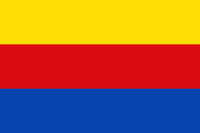 | Flag of North Holland | ||
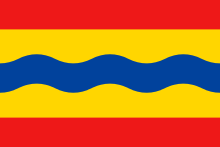 | Flag of Overijssel | ||
 | Flag of South Holland | ||
-Flag.svg.png) | Flag of Utrecht | ||
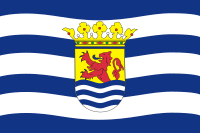 | 1949 – | Flag of Zeeland | In the centre of the flag, the coat of arms of Zeeland is depicted. The wavy blue lines represent the waves and the constant struggle against the sea. |
Portugal
| Flag | Date | Use | Description |
|---|---|---|---|
 | 1979 – | Flag of Azores | The flag of Azores has the colours of the flag of Portugal until 1910. It also has 9 stars representing the islands of the archipelago, the Portuguese shield and a Goshawk (in Portuguese Açor) that gives the name to the archipelago. It is an adaption of the first autonomy flag used during the autonomic movement in 1893, itself adapted of the then monarchist flag. |
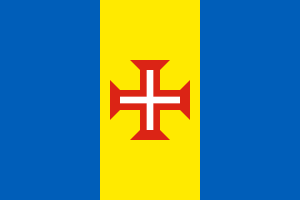 | 1978 – | Flag of Madeira | The design consists of a blue-gold-blue vertical triband with a red-bordered white Cross of Christ in the centre. |
Russia
| Flag | Date | Use | Description |
|---|---|---|---|
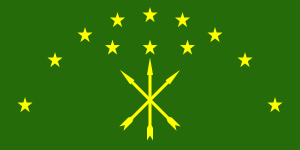 | 1992 – | Flag of Adygea | |
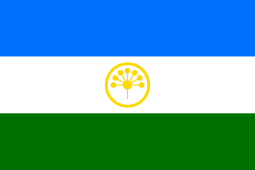 | 1992 – | Flag of Bashkortostan | |
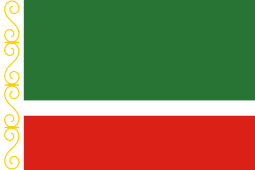 | 2004 – | Flag of Chechnya | |
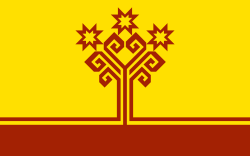 | 1992 – | Flag of Chuvashia | The flag of Chuvashia consists of a stylized tree of life, a symbol of rebirth, with the three suns, a traditional emblem popular in Chuvash art. |
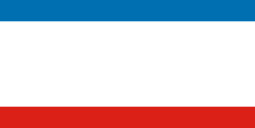 | 2014 – | Flag of Crimea | Controlled by Russia but recognized as part of Ukraine by most of the international community. Flag adopted by the Autonomous Republic of Crimea in 1992. |
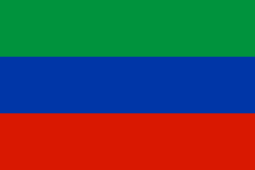 | 1994 – | Flag of Dagestan | |
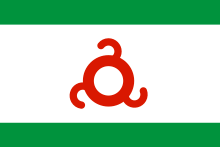 | 1994 – | Flag of Ingushetia | |
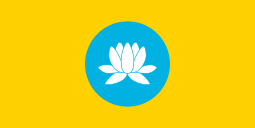 | 1993 – | Flag of Kalmykia | On the Flag of Kalmykia, the yellow stands for the sun, the people and the religious faith of the nation. The blue represents the sky, eternity, and steadiness. The lotus is a symbol of purity, spiritual rebirth and happiness. Its five upper petals represent the continents and the lower four stand for the quarters of the globe. Together, they symbolize the will of the Kalmyk Russians to live in friendship and to cooperate with all the nations of the world. |
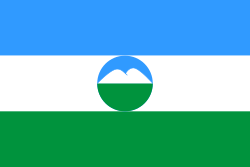 | 1994 – | Flag of Kabardino-Balkaria | |
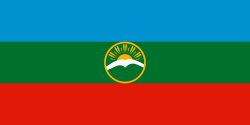 | 1996 – | Flag of Karachay-Cherkessia | |
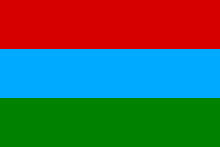 | 1993 – | Flag of Karelia | The national flag of the Republic of Karelia is a rectangle with equal horizontal stripes: the upper stripe is red, the middle one is blue and the lower is green. |
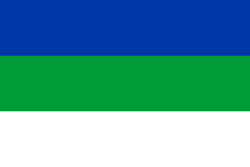 | 1997 – | Flag of the Komi Republic | The flag is a horizontal tricolour composed of three bars of, from top to bottom, medium blue, green, and white. Together, they represent Komi's natural wealth. The blue represents the splendour and spaciousness of the northern sky. The green represents nature, its bounty, and the taiga. The white represents the color of snow, the purity of nature in the north, simplicity, and austerity, as well as Komi being a country in the north. According to a different interpretation, the white represents the equality and unity of the people and cultures living in Komi. |
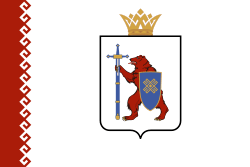 | 2011 – | Flag of Mari El | |
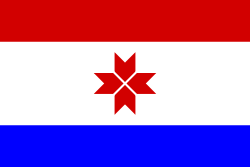 | 1995 – | Flag of Mordovia | |
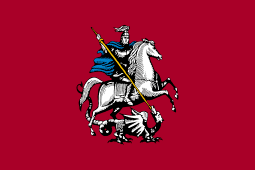 | 1995 – | Flag of Moscow | |
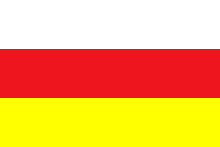 | 1991 – | Flag of North Ossetia | |
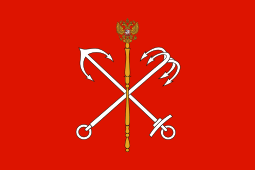 | 1991 – | Flag of Saint Petersburg | |
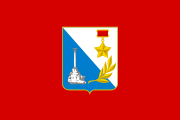 | 2000 – | Flag of Sevastopol | Controlled by Russia but recognized as part of Ukraine by most of the international community. |
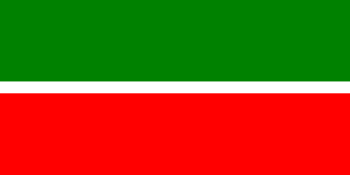 | 1991 – | Flag of Tatarstan | |
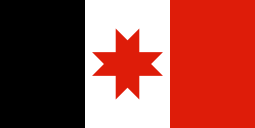 | 1993 – | Flag of Udmurtia | The cross/star symbol represents the solar sign, a protective symbol that according to folklore protects man from misfortunes. |
Serbia
| Flag | Date | Use | Description |
|---|---|---|---|
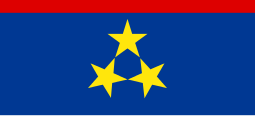 | 2004 – | Flag of Vojvodina | Horitonzal tricolour of red, blue and white with larger blue portion and three yellow stars. |
Spain
| Flag | Date | Use | Description |
|---|---|---|---|
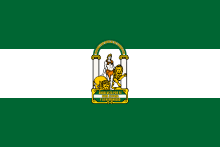 | 1918 – | Flag of Andalusia | The flag of Andalusia consists of a horizontal tricolour (green-white-green) with the Andalusian arms in the centre. |
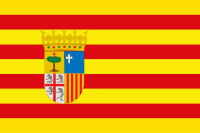 | 1982 – | Flag of Aragon | |
 | 1982 – | Flag of Asturias | The flag of Asturias is light blue with the Victory Cross slightly left of the centre. |
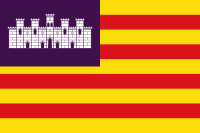 | 1983 – | Flag of the Balearic Islands | |
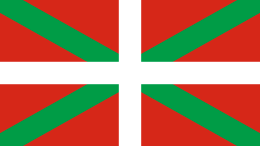 | 1978 – | Flag of the Basque Country | |
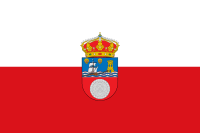 | 1984 – | Flag of Cantabria | |
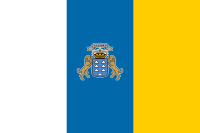 | 1982 – | Flag of the Canary Islands | The flag of the Autonomous Community of the Canary Islands is a vertical tricolour of three equal bands of white, blue, and yellow. The state flag includes the Coat of arms of the Canary Islands in the central band; the civil flag omits this. The designs were made official by the Statute of Autonomy of the Canarian Autonomous Community (Organic Law 10/82) on 16 August 1982. |
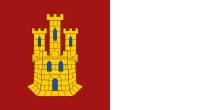 | 1982 – | Flag of Castile-La Mancha | |
 | (1230 – 1715)
1983 – |
Flag of Castile and León | It is formed by the combination of the historical flags of two of the oldest kingdom is the Iberian peninsula in the Middle Ages, the Kingdom of León (purple lion on silver in reference to the meaning of "león") and the Kingdom of Castile (golden castle on red in reference to the many castles that were erected all over the country). The joint historical flag dates back to mid 13th century when Ferdinand III, "the Saint", unified the two kingdoms in 1230, inaugurating the Kingdom of Castile and León, later named Crown of Castile. |
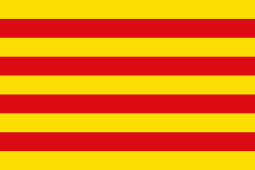 | May 25, 1933 – | Flag of Catalonia | The flag of Catalonia consists four red bars on top of a yellow background. One popular (and unproven) legend mentions this flag originating with the streaking of 4 blood-stained fingers across a plain shield. The flag derives from the royal coat of arms of the historical royal family of the Crown of Aragon, House of Trastamara. |
.svg.png) | 1983 – | Flag of Extremadura | |
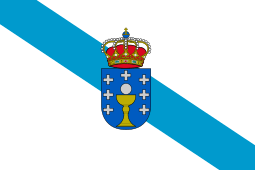 | 19th century (official from 1984) – | Flag of Galicia | The flag of Galicia appeared for the first time in the 19th century, probably based on the colours of the ancient medieval flags of the Kingdom of Galicia. Originally, the flag was a blue St Andrew's Cross over a white field—St Andrew is one of the most popular saints in Galicia. The coat of arms of Galicia was the former flag of the Kingdom of Galicia. Colors blue, white and gold were always related with Galicia. The chalice and the golden crosses on blue background have been its symbol since medieval times (13th century). For some time it was thought that it was based on the flag of the maritime province of Corunna, but today it is known that the design is earlier. |
.svg.png) | 1982 – | Flag of La Rioja | |
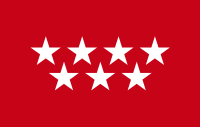 | 1983 – | Flag of the Community of Madrid | The seven stars represent the stars of the constellation Ursa Minor. They're five-pointed because they represent the five Spanish provinces which surround the Community of Madrid. |
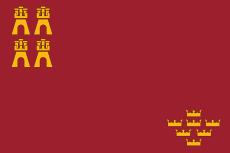 | 1982 – | Flag of the Region of Murcia | |
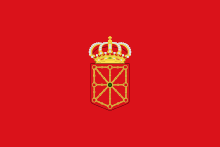 | 1982 – | Flag of Navarre | |
.svg.png) | 1982– | Flag of the Valencian Community | |
Sweden
| Flag | Date | Use | Description |
|---|---|---|---|
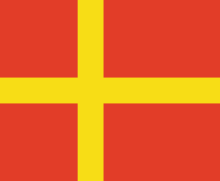 | 1902 (?) – | Flag of Scania | |
Switzerland
| Flag | Date | Use | Description |
|---|---|---|---|
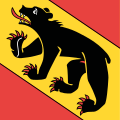 | 1289 – | Flag of Bern | |
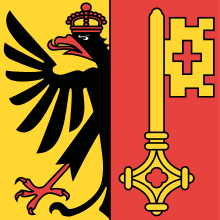 | 15th century – | Flag of Geneva | The flag of Geneva is the historical flag of the city of Geneva, showing the Imperial Eagle and a Key of St. Peter (symbolizing the status of Geneva as Reichsstadt and as episcopal seat, respectively), in use since the 15th century. |
 | 1386 – | Flag of Lucerne | |
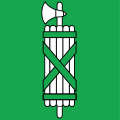 | 1803 – | Flag of St. Gallen | A white upright fasces with the axe blade facing the hoist on green field. |
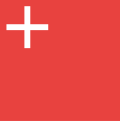 | 1240 – | Flag of Schwyz | A white banner with a cross on the top-left |
 | 13th century – | Flag of Uri | A bull's head seen face on, with a red tongue and a red nose ring, on a yellow field. |
 | 1220 (?) – | Flag of Zürich | |
Ukraine
| Flag | Date | Use | Description |
|---|---|---|---|
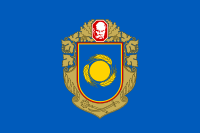 | 1998 – | Flag of Cherkasy Oblast | |
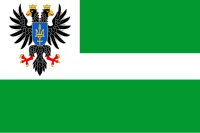 | 2000 – | Flag of Chernihiv Oblast | |
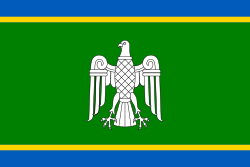 | 2001 – | Flag of Chernivtsi Oblast | |
 | 1999 – | Flag of Crimea | Controlled by Russia but recognized as part of Ukraine by most of the international community. |
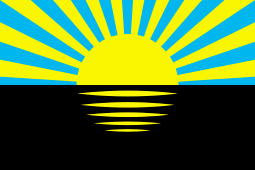 | 1999 – | Flag of Donetsk Oblast | |
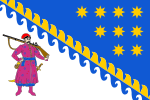 | 2002 – | Flag of Dnipropetrovsk Oblast | |
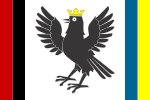 | 2001 – | Flag of Ivano-Frankivsk Oblast | |
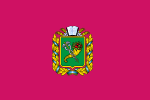 | 1999 – | Flag of Kharkiv Oblast | |
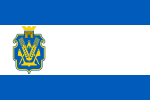 | 2001 – | Flag of Kherson Oblast | |
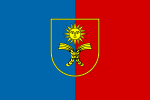 | 2002 – | Flag of Khmelnytskyi Oblast | |
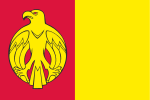 | 1998 – | Flag of Kirovohrad Oblast | |
 | 1995 – | Flag of Kiev | |
 | 1999 – | Flag of Kiev Oblast | |
 | 1998 – | Flag of Luhansk Oblast | |
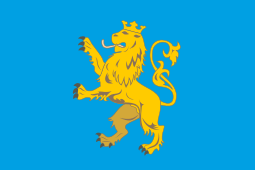 | 2001 – | Flag of Lviv Oblast | |
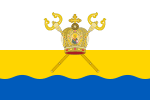 | 2001 – | Flag of Mykolaiv Oblast | |
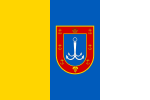 | 2002 – | Flag of Odessa Oblast | |
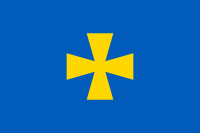 | 2000 – | Flag of Poltava Oblast | |
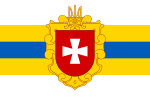 | 2005 – | Flag of Rivne Oblast | |
 | 2000 – | Flag of Sevastopol | Controlled by Russia but recognized as part of Ukraine by most of the international community. |
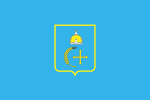 | 2000 – | Flag of Sumy Oblast | |
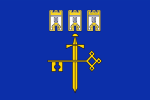 | 2003 – | Flag of Ternopil Oblast | |
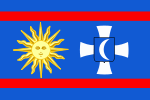 | 1997 – | Flag of Vinnytsia Oblast | |
 | 2004 – | Flag of Volyn Oblast | |
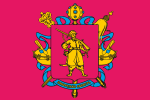 | 2001 – | Flag of Zaporizhia Oblast | |
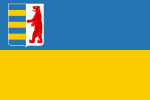 | 2009 – | Flag of Zakarpattia Oblast | |
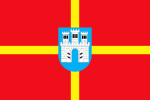 | 2003 – | Flag of Zhytomyr Oblast |
United Kingdom
| Flag | Date | Use | Description |
|---|---|---|---|
 | 16C – | Flag of England | England is a country that is part of the United Kingdom. The St George's Cross is the official national flag. |
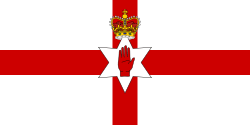 | 1953 – | Flag of Northern Ireland | Northern Ireland is a country that is part of the United Kingdom. The 'Ulster Banner' (Ulster Scots: Ulstèr Bannèr; Irish: Meirge Uladh) however is the unofficial flag as the country lacks an official flag. |
 | 14C – | Flag of Scotland | Scotland is a country that is part of the United Kingdom. The 'Saltire' is the official national flag. |
.svg.png) | 9C – | Flag of Wales | Wales is a country that is part of the United Kingdom. The Red Dragon (Welsh: Y Ddraig Goch) is the official national flag. The Welsh dragon has ancient origins, but was first officially flown in the modern era in 1959. |
Notes
See also
- Lists of flags of European countries
- List of Austrian flags
- List of Belgian flags
- List of Bosnian and Herzegovinian flags
- List of Dutch flags
- Flags of the regions of France
- List of German flags
- List of Greek flags
- List of Irish flags
- List of Italian flags
- List of flags of Montenegro
- List of flags of Norway
- List of Polish flags
- List of Portuguese flags
- List of flags of Romania
- List of Russian flags
- List of Spanish flags
- List of flags of Sweden
- Flags of Swiss cantons
- List of flags of the United Kingdom
- List of flags
- Other pages about European flags
References
- ↑ The European Parliament adopted the Council of Europe's flag in 1983.
- ↑ Adopted by the European Communities in 1986, which became the European Union in 1992 continuing its usage.
- ↑ (in German) Scheidler, Karl Hermann (1865-08-05) Illustrierte Zeitung, Leipzig, 98
- ↑ Agency, Central Intelligence (2015-11-24). The CIA World Factbook 2016. Skyhorse Publishing, Inc. ISBN 9781510700895.
- ↑ "flag of France". Encyclopædia Britannica. Retrieved 2016-10-08.
- ↑ "flag of Russia". Encyclopædia Britannica. Retrieved 2016-10-08.
- ↑ Flag of Poland
- ↑ Vinča culture
- ↑ Infos on romaniatricolor.deviantart.com
External links
![]()
